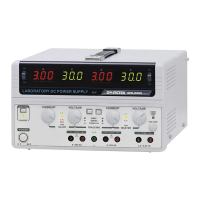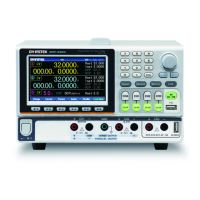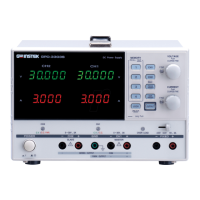MULTI-OUTPUT POWER SUPPLY
USER MANUAL
12
5. OPERATION INSTRUCTION
5-1. Precaution
(1) AC input
AC input should be within the range of line voltage ± 10% (230V
+10%~-6%) 50/60Hz.
WARNING. To avoid electrical shock, the power cord
protective grounding conductor must be connected to ground.
AVERTISS: Pour éviter les chocs électriques, le fil de terre du
cordon secteur doit impérativement être relié à la terre.
(2) Installation
Avoid using the supply in a place where ambient temperature exceeds 40℃.
The heat sink located at the rear of the supply must have sufficient air space
for radiation.
CAUTION. To avoid damaging the power supply, don’t use
it in a place where ambient temperature exceeds 40℃.
(3) Output voltage overshoot
Voltage between output terminals never exceeds the preset value when the
power is turned on or off.
5-2. Setting Current Limit
(1) Determine the maximum safe current for the device to be powered.
(2) Temporarily short the (+) and (-) terminals of the power supply together with a test
lead.
(3) Rotate the VOLTAGE control away from zero sufficiently for the CC indicator to
light.
(4) Set the meter selection switch to “A” position to select the current metering mode.
(5) Adjust the CURRENT control for the desired current limit. Read the current value
on the Ammeter.
(6) The current limit (overload protection) has now been preset. Do not change the
CURRENT control setting after this step.
(7) Remove the short between the (+) and (-) terminals and hook up for constant voltage
operation.
MULTI-OUTPUT POWER SUPPLY
USER MANUAL
13
5-3. Constant Voltage/Constant Current Characteristics
The working characteristic of these series Power Supplies is called a constant
voltage/constant current automatic crossover type. This permits continuous
transition from constant current to constant voltage modes in response to the
load change. The intersection of constant voltage and constant current modes
is called the crossover point. Fig. 5-1 shows the relationship between this
crossover point and the load.
For example, if the load is such that the power supply is operating in the
constant voltage mode, a regulated output voltage is provided. The output
voltage remains constant as the load increases, up until the point where the
present current limit is reached. At that point, the output current becomes
constant and the output voltage drops in proportion to further increases in
load. The point is indicated by the front panel LED indicators. The crossover
point is reached when the CV indicator goes off and the CC indicator comes
on.
Fig. 5-1 Constant Voltage/Constant Current Characteristic
Similarly, crossover from the constant current to the constant voltage mode
automatically occurs from a decrease in load. A good example of this would
be seen when charging a 12 volt battery. Initially, the open circuit voltage
of the power supply may be preset for 13.8 volts. A low battery will place a
heavy load on the supply and it will operate in the constant current mode,
which may be adjusted for a 1 amp charging rate. As the battery becomes
charged, and its voltage approaches 13.8 volts, its load decreases to the
point where it no longer demands the full 1 amp charging rate. This is the
crossover point where the power supply goes into the constant voltage
mode.

